المراقبة والتقييم
لا تتعلق معظم تحديات الرصد والتقييم، مثل الافتقار إلى الاستثمار والقدرات الكافية، تحديدًا بالمساعدات النقدية والقسائم. لكن تلك التي تتعلق في المقام الأول برصد نتائج عمليات النقل غير المقيدة. ويمكن أن تجعل مرونة التحويلات النقدية من الصعب تحديد مؤشرات النتائج المناسبة، لأنها قد تتضمن مجموعة من المؤشرات القطاعية والشاملة. وفي الوقت نفسه، هناك قيود على جمع بيانات دقيقة حول كيفية إنفاق التحويلات النقدية.
التزم الموقعون على الصفقة الكبرى بضمان وجود آليات الرصد والتقييم ذات الصلة فيما يتعلق بالنقد، وزيادة فهم التكاليف والفوائد والآثار والمخاطر المتعلقة بالنقد بالنسبة للطرائق الأخرى. بناءً على ذلك، يحتوي مسار الصفقة الكبرى على نقاط عمل بما في ذلك تطوير مؤشرات نتائج مشتركة للمساعدات النقدية متعددة الأغراض، ومقاييس لتحليل القيمة مقابل المال. تم تقييد التحليل المنهجي للقيمة مقابل المال بسبب عوامل تشمل عدم وجود نهج متفق عليها، والحاجة إلى بيانات نتائج عالية الجودة، وطبيعة التحليل.
الأولويات الحالية
في إطار الالتزامات النقدية للصفقة الكبرى، شاركت شبكة CALP (مع الوكالة الأمريكية للتنمية الدولية وخدمات الإغاثة الكاثوليكية) في تطوير مؤشرات النتائج للمساعدات النقدية متعددة الأغراض. وتُتاح مسودة الاختبار حاليًا باللغات الإنجليزية والفرنسية والإسبانية عبر مكتبة شبكة CALP.
Related initiatives
Featured content

Multipurpose Cash Outcome Indicators – Final Draft for Testing
Guidelines and Tools
Note that the MPC indicators have now been revised. Please click here to access the updated Multipurpose Outcome Indicators and Guidance, which is available in Arabic, English, French and Spanish. Multipurpose Cash Outcome Indicators – Final Draft for Testing Multipurpose cash (MPC) is a type of assistance intended to enable people to meet their basic needs through local...

Monitoring 4 CTP: Monitoring Guidance for CTP in Emergencies
Guidelines and Tools
This guidance provides a central resource to promote a common understanding of the most important monitoring considerations for humanitarian projects using cash transfer programming (CTP). The primary audience for this guidance is field-level practitioners, from organisations directly involved in the design, implementation, monitoring, and accountability of projects using cash and vouchers...

Cost-Efficiency Analysis of Basic Needs Programs: Best Practice Guidance for Humanitarian Agencies
Guidelines and Tools
The Efficiency, Effectiveness and Value for Money Sub-Workstream is pleased to share the final output on Cost-Efficiency Analysis of Basic Needs Programs: Best Practice Guidance for Humanitarian Agencies (attached).
Cost-efficiency analysis estimates the ratio of program costs to outputs created, allowing you to compare cost-per-output for programs which all produced the same output. Such...
Thematic lead
Latest
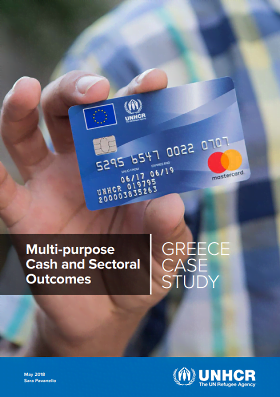
Multi-purpose Cash and Sectoral Outcomes – Greece case study
Report
Starting in 2015, the European Commission has been providing funding to support the humanitarian response in Greece through the Emergency Support to Integration & Accommodation’ (ESTIA) programme managed by its European Union Civil Protection and Humanitarian Aid (ECHO). ESTIA is implemented by UNHCR...
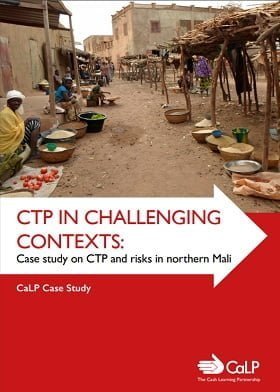
CTP in Challenging Contexts: Case study on CTP and risks in northern Mali
Report
This case study was commissioned by the the CALP Network as the first output under the 2018–2019 workstream on cash transfer programming (CTP) and associated risks. The study aims to contribute to the body of evidence on CTP-related risks and mitigation strategies by drawing lessons learnt and...

Can limited-term cash transfers confer (lasting) child protection benefits?
Presentation
The USAID-funded Aspires project, implemented by FHI360, ChildFund International and AVSI, developed evidence and programming guidance on how economic interventions can facilitate the reintegration of separated children into families, and also prevent unnecessary separation of children from their families.

E-Voucher – Electronic Voucher – Cash Based Programming
Guidelines and Tools
Last Mile Mobile Solutions, LMMS E-Voucher Electronic Solution
The Electronic Voucher provides the ability to:
– Deliver cash programmes to beneficiaries through transfer of electronic vouchers
– Enables full end-to-end digitalized tracking of transactions
– Increases security of the transfers
–...

Cash Transfer Programming in the Education and Child Protection Sectors: Literature review and Evidence maps
Report
The use of cash transfer programming (CTP) in humanitarian response continues to increase in scale and quality, as evidenced by the State of the World’s Cash Report.
This report examines the body of research that provides evidence of the impact of CTP on education and child protection outcomes and...
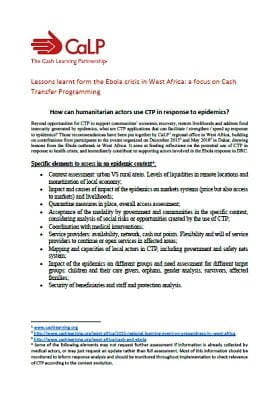
Lessons Learnt from the Ebola Crisis in West Africa: a focus on Cash Transfer Programming
Report
Beyond opportunities for CTP to support communities’ economic recovery, restore livelihoods and address food insecurity generated by epidemics, what are CTP applications that can facilitate / strengthen / speed up response to epidemics? Those recommendations have been put together by the CALP Network...
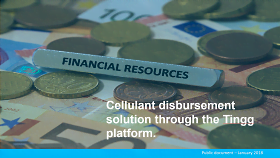
Cellulant disbursement solution through the Tingg platform
Report
Tingg brings payments and commerce all together. It provides a set of tools that enable our various users to make/receive payments online and offline. Aside of payment tools/channels, Tingg also provides a marketplace to enable very small, small and medium enterprises to easily showcase and promote their...

Cash Transfer Programming in Somaliland
Report
This report brings together reflections from a one-day learning event which took place in Hargeisa in March 2018. Participants reflected on what aspects of cash transfer programming worked well in the 2017 response and what needs to be improved going forward. In addition, there was a discussion about the...

Understanding Market Drivers in Syria
Report
Study conducted by the SIM Consortium (Syria Independent Monitoring) in partnership with iMMAP, commissioned by DFID (report initially released in January 2018). This report documents the findings of an in-depth assessment of the olive/olive oil and spice/herb market systems in northeastern and...
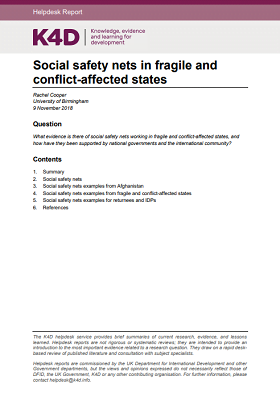
Social Safety Nets in Fragile and Conflict-Affected States
Report
This rapid review synthesises evidence on social safety net in fragile and conflict-affected states and how they have been supported by national governments and the international community. First section will discuss about the scope of social safety net and followed by examples from Afghanistan. Second...

E-Transfer implementation guide
Guidelines and Tools
This updated E-transfer Implementation Guide replaces the original guide published in 2014. In cash transfer programming (CTP), electronic transfers (e-transfers) are a digital replacement for paper vouchers or physical cash. E-transfers are a disbursement mechanism – a way of transferring money, goods...
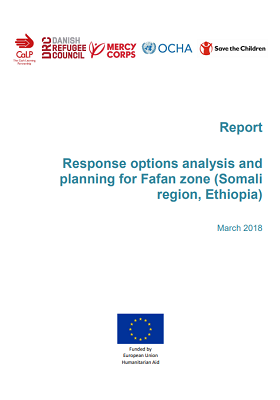
Response options analysis and planning for Fafan zone (Somali region, Ethiopia)
Guidelines and Tools
Between October 2017 and March 2018, the Consortium began the pilot in Ethiopia with the aim of providing technical and strategic support to country-based humanitarian organisations, enabling them to engage in collaborative assessments and decision making. Whilst the Consortium has not been conceived to...
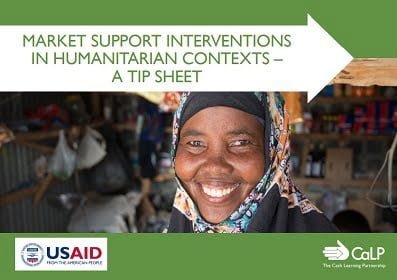
Market Support Interventions in Humanitarian Contexts – a Tip Sheet
Guidelines and Tools
This tip sheet defines what market support programming in humanitarian contexts is, and what it can look like in practice. It enables humanitarian practitioners to systematically consider market support interventions alongside other programme activities. The scope includes support interventions focusing...

Cash Transfer Programming in Armed Conflict: The ICRC’s Experience
Report
Money is the main means of survival for most people around the world. That remains the case in situations of armed conflict, when having cash to buy essential goods can mean the difference between life and death.
The ICRC’s experience shows that cash is an essential tool in humanitarian action in armed...

Cash Impact on Food Security and Non-Food Outcomes: Ministudy I
Report
To better understand how different amounts and frequencies of cash transfer impact household food security outcomes and non-food outcomes (food well-being, financial well-being, ability to cope with shocks and stresses and household well-being), this study adopted a randomised control design with two...

Tracking Cash & Voucher Assistance Workshop – Part 2: Report
Presentation
Do you want to read the latest on discussions on how to best track cash and voucher assistance in global interagency reporting systems? The CALP Network and ECHO have just released Tracking Cash & Voucher Assistance Workshop – Part 2: Report. Key recommendations emerging from the workshop are summarized...
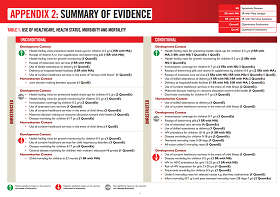
Appendix 2: Summary Of Evidence
Report
Table 1: Use of Healthcare, Health Status, Morbidity and Mortality
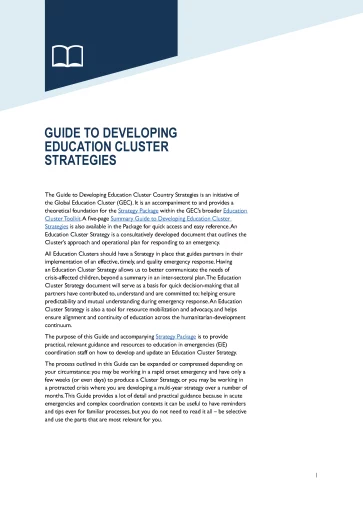
Guide to Developing Education Cluster Strategies
Guidelines and Tools
All Education Clusters should have a Strategy in place that guides partners in their implementation of an effective, timely, and quality emergency response. Having an Education Cluster Strategy allows us to better communicate the needs of crisis-affected children, beyond a summary in an inter-sectoral...

CTP Operational Models Analytical Framework
Guidelines and Tools
The State of the World’s Cash Report launched by the CALP Network in February 2018 highlights trends in the uptake of various operational models for the delivery of cash at scale in humanitarian response. Current decision making on the choice between these various operational models is highly influenced...
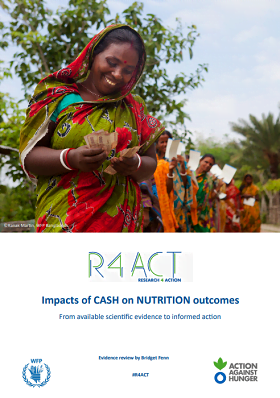
Impacts of Cash on Nutrition outcomes
Report
Following the presentation of the Grand Bargain agreement at the 2016 World Humanitarian Summit, the use of cash transfers has become a key component of humanitarian assistance and humanitarian actors and policy-makers increasingly recognize the need for more evidence-based interventions to support their...
